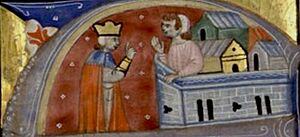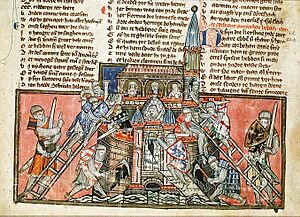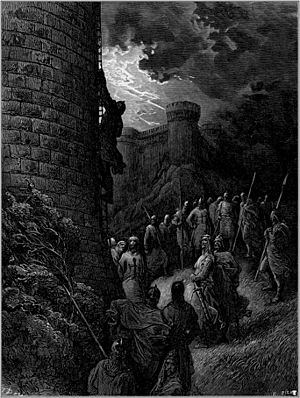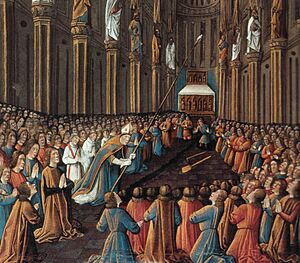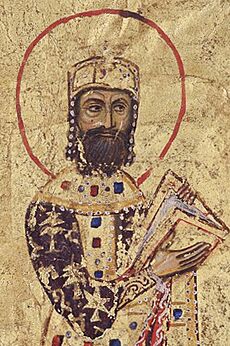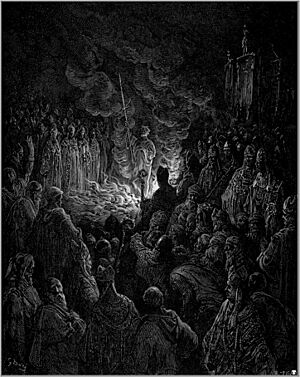Siege of Antioch facts for kids
Quick facts for kids Siege of Antioch |
|||||||||
|---|---|---|---|---|---|---|---|---|---|
| Part of the First Crusade | |||||||||
 The siege of Antioch, from a 15th-century miniature painting |
|||||||||
|
|||||||||
| Belligerents | |||||||||
| Crusaders Byzantine Empire |
|
||||||||
| Commanders and leaders | |||||||||
|
Bohemond of Taranto Stephen of Blois Hugh of Vermandois Eustace III of Boulogne Baldwin II of Hainaut Tancred of Hauteville Rainald III of Toul Gaston IV of Béarn Anselm of Ribemont Tatikios |
Yaghi-Siyan † Duqaq Toghtekin Janah ad-Dawla Fakhr al-Mulk Radwan Shams ad-Daulah Kerbogha Arslantash of Sinjar Qaradja of Harran Watthab ibn-Mahmud Balduk of Samosata Soqman ibn Ortoq Ahmad ibn-Marwan |
||||||||
| Strength | |||||||||
|
Crusaders: 2,000 light infantry and naval support |
Antiochene garrison: ~5,000 Duqaq's relief force: ~10,000 Radwan's relief force: ~12,000 Kerbogha's relief force: ~35,000–40,000 |
||||||||
| Casualties and losses | |||||||||
|
Heavy
|
Heavy
|
||||||||
| Many civilians, including Armenian and Melkite Christians and Muslims | |||||||||
The siege of Antioch was a major event during the First Crusade. It happened between October 1097 and June 1098. The crusaders were on their way to Jerusalem through a region called Syria.
There were actually two sieges. First, the crusaders attacked the city of Antioch, which was controlled by the Seljuk Empire. This siege lasted from October 1097 to June 1098. After the crusaders captured Antioch, a Seljuk army arrived and started a second siege, this time against the crusaders inside the city. This second siege led to a big battle where the crusaders won.
After their victory, the crusaders created a new state called the Principality of Antioch. It was ruled by Bohemond of Taranto.
Antioch (now called Antakya in Turkey) was very important because of its location. It controlled routes for supplies, new soldiers, and even retreats. The Seljuk governor, Yağısıyan, knew the crusaders were coming. He gathered food and asked for help from other rulers. Antioch had strong walls built by the Byzantine Empire, making it hard to capture. But the crusader leaders decided they had to take the city anyway.
The crusaders arrived on October 21 and began their attack. The city's defenders tried to break out on December 29 but failed. As food became scarce, the crusaders had to search farther away for supplies. This made them easy targets for ambushes. On December 31, about 20,000 crusaders fought and defeated a relief army from Damascus. As the siege continued into early 1098, many crusaders suffered from starvation and disease. Some even left the army.
Another relief army, led by Ridwan, arrived on February 9. Like the first army, it was defeated. The crusaders finally captured Antioch on June 3. However, the city's main fortress (citadel) remained in Turkish hands. Then, Kerbogha, a powerful leader from Mosul, began the second siege against the crusaders inside Antioch. This lasted from June 7 to June 28, 1098. The second siege ended when the crusaders marched out and defeated Kerbogha's army. Seeing their army defeated, the Turkish defenders in the citadel finally gave up.
Contents
Why Antioch Was Important
Antioch was a very important city in 1097. It was located in the Orontes Valley and covered a large area. Strong walls with 400 towers surrounded the city. The Orontes River flowed along part of its northern wall.
Mount Silpius, a high hill with a fortress (citadel) on top, was the highest point in Antioch. It rose about 1,000 feet above the valley. There were six gates to enter the city. Approaching from the south, east, or west was difficult because of the valley slopes. The easiest way to attack was from the north, where the ground was flatter.
The city's defenses were very old, built in the 6th century. Even though Antioch changed hands twice before the crusaders arrived, it was always due to betrayal, not because the walls were weak.
Antioch's Defenses and Governor
The Byzantine Empire took Antioch back in 969. They built more forts around the area to protect it. A strong citadel was built on Mount Silpius. This citadel was so high that it was almost separate from the city below. It was very hard to reach. When the Seljuk dynasty captured Antioch in 1085, it was the last Byzantine fort in Syria.
Yaghi-Siyan became the governor of Antioch in 1087. He was still in charge when the crusaders arrived in 1097.
Preparing for the Crusaders
Yaghi-Siyan knew the crusader army was coming. Antioch was directly in their path to Palestine. Most people in Antioch were Christians, even though the city was under Turkish rule. Yaghi-Siyan had been fair to Christians before. But as the crusaders got closer, he changed. He put the Christian leader, John the Oxite, in prison. He also turned a church into a stable and forced many important Christians to leave the city.
Yaghi-Siyan asked for help from other rulers. Ridwan of Aleppo refused because they didn't like each other. But other rulers, like Duqaq of Damascus and Kerbogha from Mosul, agreed to send soldiers. Yaghi-Siyan also started storing food and supplies for a long siege.
The crusaders knew they had to capture Antioch. They thought about waiting for more soldiers to arrive in spring. A Byzantine advisor suggested blocking the city's supply lines from a distance. But the crusaders decided to move closer and start a direct siege.
The First Siege Begins
To start the siege properly, the crusaders needed to control three key places. These were the town of Artah, the Iron Bridge over the Orontes River, and the harbor of St Simeon.
A group of crusaders led by Robert of Flanders went to take Artah. They found that local Armenian Christians had already kicked out the Turkish soldiers. The Armenians welcomed Robert and gave his men supplies. Yaghi-Siyan sent his own soldiers to retake Artah, but they retreated when the main crusader army arrived.
On October 20, 1097, the crusaders reached the Iron Bridge. This was a strong crossing about 12 miles outside Antioch. Robert of Flanders and Adhemar of Le Puy, a Catholic bishop, led the attack across the bridge. This opened the way for the rest of the army.
Bohemond of Taranto led the first group along the river's south bank. They reached Antioch on October 21. The crusaders set up their camps outside the city's north wall. They divided into several groups around the city. Bohemond camped near Saint Paul's Gate. Other leaders like Godfrey of Bouillon and Raymond IV of Toulouse also took positions around the walls. The bridge outside Antioch's west walls remained under Yaghi-Siyan's control. This siege lasted for nine months and was one of the most important sieges of that time.

The crusaders knew that a direct attack on the city would fail. Antioch was too well protected. One chaplain said that Antioch was "so well fortified that it need not fear attack." The city's defenders included about 2,000 skilled knights and many more foot soldiers.
Camping so close to the city meant the crusaders could be attacked by the defenders. For the first two weeks, the crusaders could find food easily nearby. But in November, Yaghi-Siyan learned that the crusaders wouldn't attack directly. So, he started sending his cavalry to bother the crusaders. As the crusaders had to search farther for food, they were often ambushed. Yaghi-Siyan's men also used the Dog Bridge to attack the crusaders. The crusaders tried to destroy this bridge but couldn't. They eventually built a blockade on the bridge to stop attacks.
The port of St Symeon, about 9 miles west of Antioch, was important for supplies. Reinforcements arrived there on November 17, including 13 ships from Genoa. The route from St Symeon to Antioch was close to the city walls, making it dangerous. Bohemond's troops built a small fort called Malregard to protect themselves from attacks. The crusaders also got stronger when Tancred arrived with his men.
Winter Hardships
By December, the crusaders were running out of food. Many were starving. On December 28, Bohemond and Robert of Flanders took about 20,000 men to find food. Yaghi-Siyan saw his chance. On December 29, he attacked Raymond's camp. Raymond's men were surprised but fought back. They almost captured the city gates, but the crusaders panicked in the dark and retreated. Both sides lost soldiers.
While Raymond was fighting, an army led by Duqaq of Damascus was coming to help Antioch. Bohemond and Robert's foraging party didn't know they were heading towards Duqaq's army. On December 31, the two armies met. Bohemond and Robert fought hard and defeated Duqaq's army, causing many losses. Even though they won, the crusaders had too many casualties to continue foraging. They returned to Antioch with less food than they needed.
The end of December was bad for everyone. There was an earthquake on December 30. Then, there was very bad rain and cold weather. Duqaq had to go home. The crusaders thought the bad weather was a sign from God. They started a three-day fast to ask for forgiveness. Food supplies were dangerously low. Soon, one out of every seven crusaders was dying from starvation.
Local Christians brought food, but they charged very high prices. The horses also suffered, and soon only 700 were left. Many crusaders died from hunger. Some knights and soldiers started to leave the army in January 1098. Even important people like Peter the Hermit deserted. Bohemond sent soldiers to bring them back. Peter was forgiven, but others were made to promise they would stay.
Spring Brings Hope
When spring arrived in February, the food situation improved for the crusaders. The Byzantine advisor, Tatikios, again suggested a long-distance blockade, but his idea was ignored. He then left the army and went home. Tatikios told the Byzantine Emperor Alexios I Komnenos that Bohemond planned to kill him. Bohemond's friends said Tatikios was a traitor. They used this as a reason to break their promise to return Antioch to the Byzantines.
News came that another Seljuk army was approaching. Bohemond used this situation to his advantage. He said he would leave unless he was allowed to keep Antioch for himself after it was captured. Godfrey and Raymond didn't agree to his demands. But Bohemond gained the support of the regular soldiers and less important knights.
Yaghi-Siyan had made peace with Ridwan of Aleppo. Ridwan's army was now advancing. In early February, the crusaders learned that Ridwan had taken a nearby town and was preparing to attack Antioch. Bohemond suggested that the crusaders send all their cavalry (about 700 knights) to meet Ridwan's army. The infantry stayed behind to guard against an attack from Antioch.
On February 9, Ridwan's army moved towards the Iron Bridge. The crusaders had moved into position the night before. They charged Ridwan's army before it reached the bridge. The first charge didn't cause many losses. But Ridwan's army followed the crusaders to a narrow battlefield. With the river on one side and the Lake of Antioch on the other, Ridwan couldn't use his larger numbers to surround the crusaders. A second charge had more impact, and the Seljuk army retreated in confusion.
At the same time, Yaghi-Siyan led his soldiers out of Antioch and attacked the crusader infantry. His attack pushed the crusaders back until the knights returned. When Yaghi-Siyan realized Ridwan had been defeated, he retreated back into the city. As Ridwan's army passed through the town he had taken, his soldiers panicked and left the town. Christians then took it back.
An English fleet, possibly led by Edgar Ætheling, arrived at St Symeon on March 4. It brought supplies from the Byzantines. The fleet brought materials to build siege engines. These materials were almost lost on the way to Antioch when some of the city's defenders attacked. Bohemond and Raymond protected the materials, but they still lost some supplies and 100 people. They fell back to the crusader camp.
Rumors reached Godfrey that Bohemond and Raymond had been killed. He prepared his men to rescue any survivors. But then another group of defenders attacked from the city. Godfrey held them off until Bohemond and Raymond arrived. The crusaders then chased the defenders back to Antioch's walls. This counter-attack was a success. Between 1,200 and 1,500 of Antioch's defenders were killed.
The crusaders started building siege engines. They also built a fort called La Mahomerie to block the Bridge Gate. This stopped Yaghi-Siyan from attacking the crusader supply line from the ports. They also repaired an abandoned monastery, which was used to deliver food to the city. Tancred guarded this monastery, now called Tancred's Fort. Raymond of Toulouse took control of La Mahomerie. Finally, the crusader siege began to have a real effect on the city. Food conditions improved for the crusaders as spring continued, and the city was cut off from outside help.
Talks with Egypt
In April, a group from Fatimid Egypt arrived at the crusader camp. They hoped to make peace with the Christians. The Fatimids were enemies of the Seljuks, so they saw the crusaders as potential allies. Peter the Hermit was sent to talk with them.
These talks didn't lead to anything. The Fatimids thought the crusaders were just soldiers working for the Byzantines. They were willing to let the crusaders keep Syria if they promised not to attack Fatimid Palestine. This kind of agreement was normal between Egypt and Byzantium before the Turkish invasions. But the crusaders couldn't agree to anything that didn't give them Jerusalem. Even so, the Fatimids were treated well and given gifts. No final agreement was reached. This meeting taught the crusaders the value of talking things out. They decided to send a group to Duqaq of Damascus to ask for his neutrality. They told him they didn't want his land. However, Duqaq refused their offer.
Antioch Is Captured
The siege continued. At the end of May 1098, a large Turkish army from Mosul arrived. It was led by Kerbogha. This army was much bigger than the previous relief attempts. Kerbogha had joined forces with Ridwan and Duqaq. His army also included soldiers from Persia and other regions.
Luckily for the crusaders, Kerbogha first spent three weeks trying to recapture Edessa. He failed to take it from Baldwin of Boulogne, who had become its ruler. This delay gave the crusaders time to prepare.
The crusaders realized they had to capture Antioch before Kerbogha's army arrived. Weeks earlier, Bohemond had secretly contacted a guard inside the city named Firouz. Firouz was an Armenian who controlled a tower called the Tower of the Two Sisters. His reasons for helping were unclear, maybe greed or revenge. He offered to let Bohemond into the city for money and a title.
Bohemond then told the other crusader leaders about Firouz's offer. He said he would give them access to the city if they agreed to make him the Prince of Antioch. Raymond was very angry. He argued that the city should be given to Alexios, as they had promised when they left Constantinople. But Godfrey, Tancred, Robert, and the other leaders were desperate. They agreed to Bohemond's demand.
Despite this, on June 2, Stephen of Blois and some other crusaders left the army. Later that day, Firouz told Bohemond to pretend to march south over the mountains to face Kerbogha. Then, Bohemond was to secretly return at night and climb the walls at Firouz's tower. This plan worked. Firouz let a small group of crusaders climb the tower. They then opened a nearby hidden gate, allowing a larger group of soldiers to enter the city. These soldiers quickly overwhelmed the surprised defenders.
While Bohemond tried to capture the main fortress, the poorer crusaders looted everything they could find. In the chaos, Armenians and Greeks joined the crusaders in fighting the Turks. Sadly, many non-Turkish civilians were also killed, including Firouz's own brother. Yaghi-Siyan tried to escape but was caught by Armenian and Syrian Christians outside the city and killed.

The Second Siege Begins
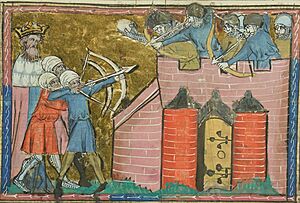
By the end of June 3, the crusaders controlled most of Antioch. Only the citadel (main fortress) remained in the hands of Yaghi-Siyan's son. Adhemar of Le Puy, a church leader, brought back John the Oxite as the Christian leader of Antioch. This was to keep good relations with the Byzantines, especially since Bohemond clearly wanted the city for himself.
However, the city was now low on food, and Kerbogha's army was still coming. Kerbogha arrived just two days later, on June 5. He tried to storm the city on June 7 but failed. By June 9, he had started his own siege around Antioch.
More crusaders had left before Kerbogha arrived. They joined Stephen of Blois in Tarsus. Stephen had seen Kerbogha's huge army and thought all hope was lost. The deserters confirmed his fears. On their way back to Constantinople, Stephen and the others met Emperor Alexios. Alexios was coming to help the crusaders, but he didn't know they had captured Antioch and were now under siege themselves. Stephen convinced him that the crusaders were doomed. Alexios also heard that another Seljuk army was nearby. So, he decided to return to Constantinople instead of risking battle.
Finding the Holy Lance
Meanwhile, inside Antioch, something amazing happened. On June 10, a priest named Peter Bartholomew claimed he had visions of St. Andrew. St. Andrew told him that the Holy Lance was hidden inside the city. The starving crusaders were having many visions and seeing things. Another monk also reported visions of Christ and the Virgin Mary. On June 14, a meteor was seen landing in the enemy camp. This was seen as a good sign.
Adhemar was suspicious because he had seen a relic of the Holy Lance in Constantinople. But Raymond believed Peter. Raymond, along with others, started digging in the cathedral of Saint Peter on June 15. When they found nothing, Peter went into the pit himself. He reached down and pulled out a spear point. Raymond saw this as a sign from God that they would survive. He then prepared for a final battle instead of surrendering. Peter then reported another vision. St. Andrew told the crusader army to fast for five days (even though they were already starving). After the fast, they would win.
Bohemond was also doubtful about the Holy Lance. But there's no doubt that finding it greatly boosted the crusaders' spirits. Some historians think Peter might have found an object that the local people already believed was the Holy Lance. Greek Orthodox records show that a Holy Lance was honored in Antioch as early as the tenth century. It's also possible that Peter was saying what Bohemond wanted to hear. Bohemond knew from spies that Kerbogha's different groups often argued. Kerbogha was seen by most other leaders as a bigger threat than the Christians.
On June 27, Peter the Hermit was sent to talk with Kerbogha. But the talks failed, and a battle was unavoidable. Bohemond divided his army into six groups. He led one himself. The others were led by Hugh of Vermandois, Robert of Flanders, Godfrey, Robert of Normandy, Adhemar, and Tancred. Raymond, who was sick, stayed inside to guard the citadel with 200 men. The citadel was now held by one of Kerbogha's men.
The Battle of Antioch
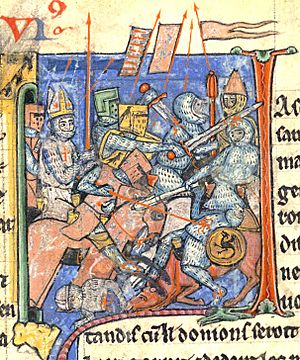
On Monday, June 28, the crusaders marched out of the city gate. Raymond of Aguilers carried the Holy Lance in front of them. Kerbogha hesitated, even though his generals urged him to attack. He hoped to attack all the crusader groups at once. But he didn't realize how large their army was. He pretended to retreat to draw the crusaders onto rougher ground. His archers kept shooting arrows at the advancing crusaders.
A group of Kerbogha's soldiers was sent to attack the crusader left side, which wasn't protected by the river. But Bohemond quickly formed a seventh group and pushed them back. The Seljuks were causing many casualties. Kerbogha even set fire to the grass between his position and the crusaders. But this didn't stop them. The crusaders had visions of three saints riding with them: St. George, St. Mercurius, and St. Demetrius.
The battle was short and a disaster for the Seljuk empire. Duqaq left Kerbogha, as did other leaders. This greatly reduced the Turkish army's numbers. Soon, the defeated Turkish soldiers were running away in a panic.
What Happened Next
As Kerbogha fled, the citadel, which was under the command of Ahmed ibn Merwan, finally surrendered. But it surrendered only to Bohemond personally, not to Raymond. This seemed to have been planned beforehand without Raymond knowing. As expected, Bohemond claimed the city for himself, even though Adhemar and Raymond disagreed.
Two crusader leaders were sent to Constantinople to tell Emperor Alexios the news. However, Alexios was not interested in sending an army to claim the city so late in the summer. Back in Antioch, Bohemond argued that Alexios had abandoned the crusade. This, he said, meant that all their promises to him were no longer valid. Bohemond and Raymond lived in Yaghi-Siyan's palace. But Bohemond controlled most of the city and put his flag on the citadel. It's often thought that the different groups of crusaders (from northern France, southern France, and southern Italy) wanted to increase their own power. This might have caused some of the arguments, but personal ambition was probably the main reason.
Soon, a sickness spread, possibly typhus. On August 1, Adhemar of Le Puy died. In September, the crusader leaders wrote to Pope Urban II, asking him to take control of Antioch. But he refused. For the rest of 1098, they took control of the countryside around Antioch. However, they had even fewer horses than before, and local farmers refused to give them food. The regular soldiers became restless and started to starve. They threatened to continue to Jerusalem without their arguing leaders. In November, Raymond finally gave in to Bohemond. This was so the crusade could continue peacefully and to calm his starving troops.
At the beginning of 1099, the march to Jerusalem started again. Bohemond stayed behind as the first Prince of Antioch. In the spring, the siege of Jerusalem began, led by Raymond.
The success at Antioch was too much for those who doubted Peter Bartholomew. Peter's visions seemed too convenient and too focused on war. He was openly accused of lying. To prove he was guided by God, Peter offered to undergo an ordeal by fire. They chose an old test: Peter would walk through a fiery furnace, and an angel of God would protect him. The crusaders built a path between walls of flame. Peter walked through them and was terribly burned. He died after suffering for twelve days on April 20, 1099. After this, not much more was said about the Holy Lance. However, Raymond's group still believed Peter had passed safely through the flames but was pushed back by the crowd. Raymond also kept the Lance in his chapel with great respect.
The siege of Antioch quickly became famous. In the 12th century, it was the subject of two long poems called chanson d'Antioche and Siège d'Antioche.
The historical novel Count Bohemond by Alfred Duggan (1964) tells the story of Bohemond's life and describes the siege of Antioch.
Images for kids
See also
 In Spanish: Sitio de Antioquía (1097-1098) para niños
In Spanish: Sitio de Antioquía (1097-1098) para niños


